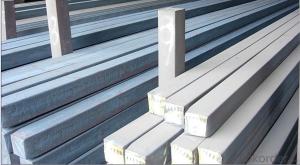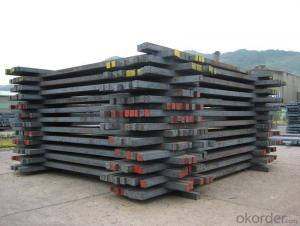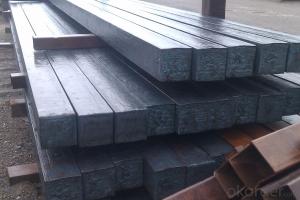Q235/3SP 120MM Blast Furnace Hot Rolled Steel Billet
- Loading Port:
- Tianjin
- Payment Terms:
- TT OR LC
- Min Order Qty:
- 2000 m.t.
- Supply Capability:
- 30000 m.t./month
OKorder Service Pledge
OKorder Financial Service
You Might Also Like
Description of Q235/3SP 120MM Blast Furnace Hot Rolled Steel Billet
Our hot dip galvanised steels consist of a steel substrate with a metallic zinc coating applied by means of a continuous hot dip galvanising process. Metallic zinc coatings are available in steel grades ranging from steel for bending and deep drawing applications, to structural steels and high yield strength steels.
A glossy surface finish obtained under specific skin-pass conditions (either non-skin-passed or skin- passed with smooth cylinders to obtain low roughness) can be provided if required at time of enquiry.
Advantage of Q235/3SP 120MM Blast Furnace Hot Rolled Steel Billet
Uncoated CR steel sheet With the features of in line with the international highest standards in demension and shape, excellent surface finish and properties, the products are mainly used in home appliance and automobile industries.
Galvanized steel sheet(include HDG and EG)
With the features of good corrosion resistance, the products are mainly used in automobile, home appliance, electronics, building and machinery manufacture industries, etc.
Precoated steel sheet With the features of enviromental protection and good processablility, long lasting surface durability, rich in colors, the products are maily used in building, home appliance and furniture industries, etc.
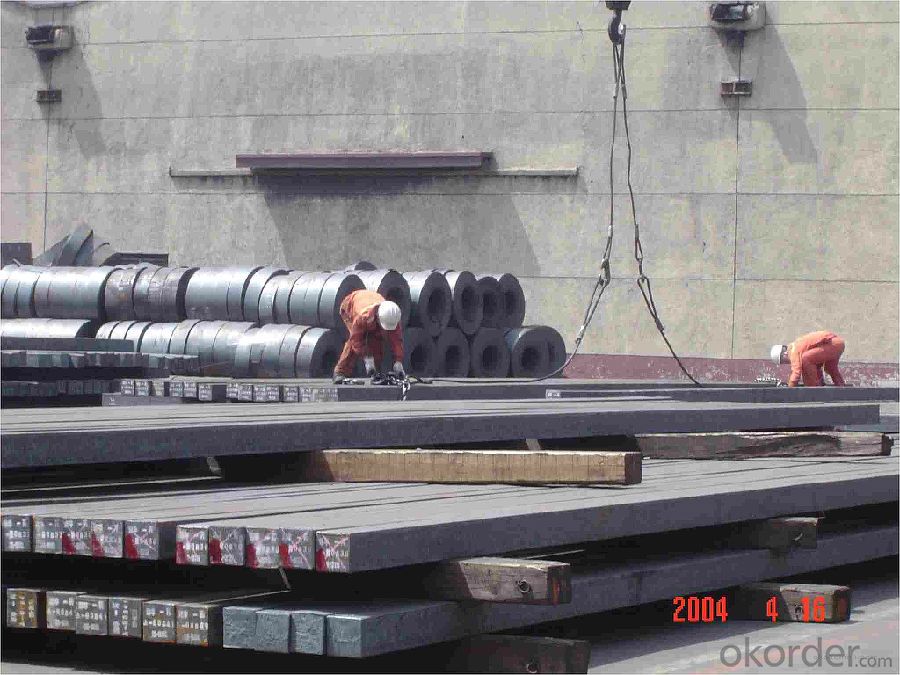
Applications of Q235/3SP 120MM Blast Furnace Hot Rolled Steel Billet
Our hot dip galvanised steels can be used in a very wide range of applications for industrial markets, both indoors and outdoors. Some of the most common applications are:
Building: wide sections for roofing and cladding, doors, door frames, metallic ceilings, partitions, structural members etc
Domestic appliances: all appliances for this sector (both white and brown goods) are manufactured with hot dip galvanised steels
Miscellaneous: electrical cabinets, aeraulic components, air conditioners, road signs etc
Zinc hot dip galvanised steel is suitable for contact with foodstuffs under certain conditions, as specified in European directive 89/109/EEC and French standard NF A 36-712-1. Please contact us for further information on this subject.
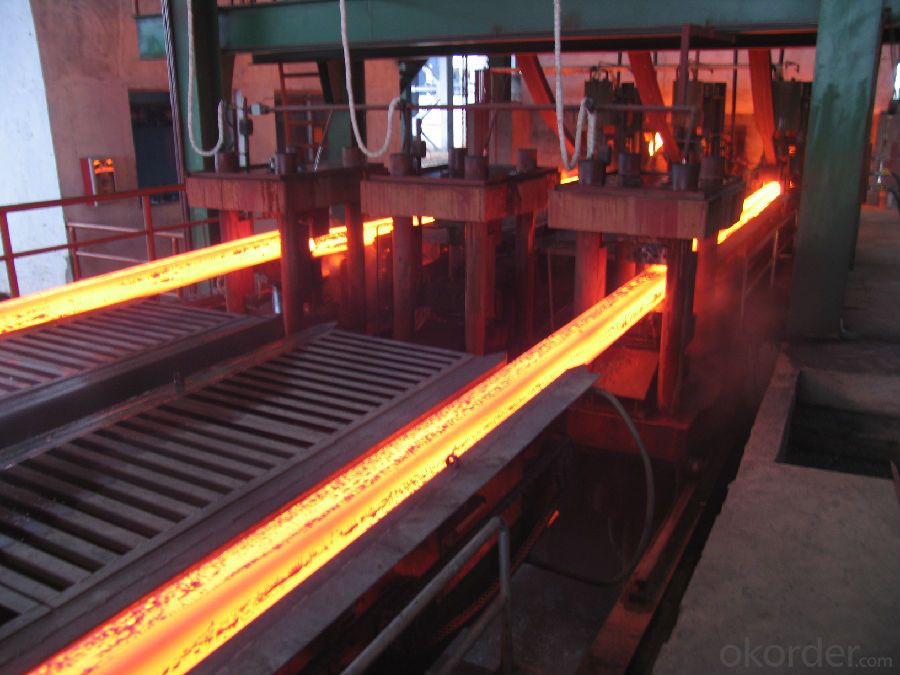
Specifications of Q235/3SP 120MM Blast Furnace Hot Rolled Steel Billet
Quality | Q/BQB 440-2003 | JIS G3312-1994 JIS G3321 | EN 10326-2004 | ASTM A653-02a |
EN 10327-2004 | (BASE PLATE) | |||
(BASE PLATE) | ||||
Commercial Steel | DC51D | SGCC SGLCC | DX51D+Z DX51D+AZ | CS Type A/B/C |
Forming Steel | St01,St02,St03 | SGCD1 SGLCD1 | FS Type A, Type B | |
Drawing | DC52D /DC53D | - | DX52D+Z DX52D+AZ | DDS TYPE A/C |
Steel | DX53D+Z DX53D+AZ | |||
Structural | S280GD (StE28) | SGC400 SGLC400 | S280D+Z DX54D+AZ | SS275 |
Steel | S350GD (StE34) | SGC440 SGLC440 | S350D+Z S350D+AZ | SS340 Class1 |
FAQ of Q235/3SP 120MM Blast Furnace Hot Rolled Steel Billet
We have organized several common questions for our clients,may help you sincerely:
1. How Can I Visit There?
Our company is located in Tianjin City, China, near Beijing. You can fly to Tianjin Airport Directly. All our clients, from home or aboard, are warmly welcome to visit us!
2. How Can I Get Some Sample?
We are honored to offer you sample.
3. Why choose CNBM?
Our delivery time about 15-20days for standard sizes, if you have other requirements like hardness, quanity and width ,it is about 20-40days. But don't worry we also try our best for the delivery time ,because time longer and our cost is higher.
- Q:How are steel billets used in the production of valves?
- Steel billets are an integral component in the production of valves as they serve as the raw material for manufacturing valve bodies. Valve bodies are the main structural component of valves, providing the necessary strength and durability to withstand the high pressures and temperatures they are subjected to in various applications. To produce valve bodies, steel billets undergo several manufacturing processes. Initially, the billets are heated and then passed through a series of rollers to shape them into the desired form, typically a cylindrical or rectangular shape. This process, known as hot rolling, enhances the mechanical properties of the steel, making it more suitable for valve applications. After the hot rolling process, the steel billets are further processed through forging or machining operations to refine their shape and dimensions. Forging involves applying compressive forces to the heated billets, reshaping them into the final valve body form. On the other hand, machining involves removing excess material through cutting, drilling, and shaping to achieve the desired dimensions and surface finish. Once the valve bodies are formed, further processes such as drilling, threading, and finishing are carried out to create the necessary openings, connections, and surface smoothness required for the valve's functionality. These processes may involve using specialized machinery and tools to ensure precise and accurate dimensions. Overall, steel billets are crucial in the production of valves as they serve as the starting point for creating the valve bodies. The properties of steel, combined with the various manufacturing processes, enable the production of high-quality valves that can effectively control the flow of fluids or gases in various industrial applications.
- Q:How is the quality of steel billets ensured during the manufacturing process?
- The quality of steel billets is ensured during the manufacturing process through various measures such as rigorous inspection and testing procedures. These include visual inspections, dimensional checks, and non-destructive testing techniques like ultrasonic testing or magnetic particle inspection. Additionally, chemical analysis is conducted to verify the composition of the steel billets, ensuring they meet the required specifications. By implementing these quality control measures, any potential defects or inconsistencies can be identified and addressed promptly, ensuring the production of high-quality steel billets.
- Q:What are the different types of steel billet surface treatments?
- There are several different types of steel billet surface treatments, including pickling, shot blasting, and painting. Pickling involves removing impurities and oxides from the surface of the billet using an acid solution. Shot blasting is a process in which small metallic or abrasive particles are blasted onto the surface of the billet to remove rust, scale, and other contaminants. Painting involves applying a protective coating or layer of paint to the surface of the billet to prevent corrosion and improve its appearance.
- Q:How are steel billets formed into other shapes?
- Steel billets are formed into other shapes through a process called hot rolling or cold rolling. Hot rolling involves heating the steel billet to a high temperature and then passing it through a series of rollers to apply pressure and shape it into the desired form. This process is typically used for larger and more complex shapes such as beams, channels, and angles. On the other hand, cold rolling is performed at room temperature, and it involves passing the steel billet through a series of rollers to gradually reduce its thickness and shape it into sheets, strips, or coils. Cold rolling is commonly used for producing thinner and more precise shapes like plates, foils, and bars. In addition to rolling, steel billets can also be formed into other shapes through processes such as forging, extrusion, and casting. Forging involves applying pressure to the heated billet using a die or hammer to shape it into the desired form. Extrusion involves pushing the heated billet through a die to produce long and continuous shapes like pipes or tubes. Casting involves pouring molten steel into a mold and allowing it to solidify into the desired shape. Overall, the formation of steel billets into other shapes requires various manufacturing processes such as hot rolling, cold rolling, forging, extrusion, or casting, depending on the desired shape and properties of the final product. These processes ensure that steel billets can be transformed into a wide range of shapes for different applications in industries such as construction, automotive, aerospace, and manufacturing.
- Q:Billet heating furnace billet temperature reached, steel will be adhesion
- As soon as the melting point is reached, the part melts before sticking. But heating will swell a lot, you need to leave enough space.
- Q:How are steel billets used in the production of automotive exhaust systems?
- Steel billets are an essential component in the production of automotive exhaust systems. These billets, which are solid blocks of steel, serve as the raw material for various parts and components of the exhaust system. The first step in using steel billets is to heat them in a furnace to a specific temperature in order to soften the steel and make it malleable. Once heated, the billets are then shaped and formed into different parts of the exhaust system, such as pipes, mufflers, and catalytic converters. This shaping process can be done through hot rolling, cold rolling, or extrusion, depending on the desired shape and properties of the component. After shaping, the steel billets are further processed to enhance their strength and durability. This can involve heat treatment processes like quenching and tempering, which improve the steel's hardness, toughness, and resistance to corrosion. These treatments ensure that the exhaust system components can withstand the harsh conditions they will be exposed to, such as high temperatures and corrosive gases. Once the steel billets have been shaped and treated, they are then assembled and welded together to form the final exhaust system. This involves joining the various components, such as pipes and mufflers, through welding techniques like arc welding or laser welding. These welding processes ensure that the components are securely connected, preventing any leaks or failures in the exhaust system. Overall, steel billets play a crucial role in the production of automotive exhaust systems by providing the necessary raw material for shaping and forming the various components. Their strength, durability, and resistance to high temperatures and corrosion make them an ideal choice for manufacturing exhaust systems that can withstand the demanding conditions of automotive use.
- Q:How are steel billets used in the production of construction components?
- Steel billets are an intermediate product used in the production of construction components. They are typically heated and then shaped into various forms such as beams, columns, or rods, which are essential for constructing buildings, bridges, and other structures.
- Q:How are steel billets stored to prevent corrosion?
- In order to prevent corrosion, steel billets are typically stored in a manner that avoids direct contact with moisture and oxygen, which are the primary culprits. One common approach involves keeping the billets indoors in a controlled environment, such as a warehouse or storage facility. These facilities are specially designed to maintain low levels of humidity and often feature climate control systems for temperature and moisture regulation. To provide further protection against corrosion, steel billets can be placed on wooden pallets or racks. This ensures that they are kept away from the ground and any potential sources of moisture. Additionally, it is customary to apply a protective coating or oil film on the surface of the billets before storing them. This coating acts as a barrier, preventing moisture and oxygen from directly contacting the steel and reducing the risk of corrosion. Regular inspections and maintenance are crucial to promptly identify and address any signs of corrosion. This may involve periodic cleaning, applying additional protective coatings, or implementing other preventive measures as needed. By storing steel billets in a controlled environment, applying protective coatings, and conducting regular inspections, the risk of corrosion can be significantly minimized. This ensures that the billets remain in optimal condition for future use.
- Q:How do steel billets contribute to the mining industry?
- The mining industry relies heavily on steel billets, as they play a critical role in the manufacturing of various mining equipment and infrastructure. These semi-finished steel products are used to produce a wide range of tools and machinery necessary for mining activities. One of the primary uses of steel billets in the mining sector is in the creation of mining machinery and equipment. These billets are utilized to construct the structural components of heavy machinery like excavators, bulldozers, and drilling rigs. The strength and durability of steel make it an excellent material choice for these applications, as it can withstand the harsh conditions and heavy loads encountered in mining operations. Steel billets are also essential in the construction of mining infrastructure. The establishment of structures such as conveyor systems, processing plants, and storage facilities is a crucial aspect of mining operations. By using steel billets, the structural elements of these buildings can be fabricated to provide the necessary strength and stability needed to support mining activities. Additionally, steel billets are vital in the manufacturing of mining tools and equipment. Tools like drills, hammers, and picks are made from steel billets due to their strength and hardness. These tools are utilized throughout various mining processes, including exploration, extraction, and mineral processing. Moreover, steel billets contribute to the mining industry by facilitating the transportation of extracted minerals. The production of rail tracks and wagons, both of which are made from steel billets, is necessary for the efficient transportation of minerals from mining sites to processing facilities or ports for export. In conclusion, steel billets are an indispensable component of the mining industry. They support the production of machinery, infrastructure, tools, and transportation systems. With their strength, durability, and versatility, steel billets play a crucial role in driving the growth and efficiency of the mining sector.
- Q:How are steel billets used in the production of construction equipment?
- Steel billets are an integral component in the production of construction equipment. These billets, which are essentially semi-finished steel forms, serve as the raw material for various construction equipment components. They are typically manufactured through a process called continuous casting, where molten steel is solidified in molds to form solid rectangular or square billets. Once steel billets are obtained, they undergo further processing to transform them into the desired construction equipment parts. This involves shaping, cutting, and machining the billets to create components such as gears, shafts, axles, and structural frames. The versatility of steel allows for customization of these components to meet the specific requirements of different construction equipment. The use of steel billets in construction equipment production offers several advantages. Firstly, steel is known for its exceptional strength and durability, making it ideal for heavy-duty applications. By using steel billets, construction equipment manufacturers can ensure that their products can withstand the demanding conditions of construction sites and provide long-lasting performance. Additionally, steel billets can be easily welded, allowing for the assembly of complex structures and components. This welding capability is crucial in the production of construction equipment, where multiple parts need to be securely joined together to form a robust and reliable machine. Furthermore, steel billets offer excellent machinability, meaning they can be easily shaped and formed into the desired dimensions. This allows for precise manufacturing of intricate components, enhancing the overall performance and functionality of the construction equipment. Lastly, steel billets are readily available in a wide range of grades and compositions, enabling manufacturers to select the most suitable steel alloy for their specific construction equipment applications. This flexibility allows for the optimization of the equipment's performance, weight, and cost-effectiveness. In conclusion, steel billets play a vital role in the production of construction equipment by serving as the raw material for various components. Their strength, durability, weldability, machinability, and wide range of available alloys make them an ideal choice for manufacturing construction equipment that can withstand the demanding conditions of construction sites and deliver long-lasting performance.
1. Manufacturer Overview |
|
|---|---|
| Location | |
| Year Established | |
| Annual Output Value | |
| Main Markets | |
| Company Certifications | |
2. Manufacturer Certificates |
|
|---|---|
| a) Certification Name | |
| Range | |
| Reference | |
| Validity Period | |
3. Manufacturer Capability |
|
|---|---|
| a)Trade Capacity | |
| Nearest Port | |
| Export Percentage | |
| No.of Employees in Trade Department | |
| Language Spoken: | |
| b)Factory Information | |
| Factory Size: | |
| No. of Production Lines | |
| Contract Manufacturing | |
| Product Price Range | |
Send your message to us
Q235/3SP 120MM Blast Furnace Hot Rolled Steel Billet
- Loading Port:
- Tianjin
- Payment Terms:
- TT OR LC
- Min Order Qty:
- 2000 m.t.
- Supply Capability:
- 30000 m.t./month
OKorder Service Pledge
OKorder Financial Service
Similar products
New products
Hot products
Hot Searches
Related keywords
